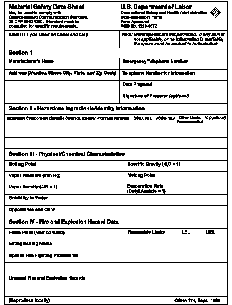 |
Hazard Communication |
|
| HAZCOM Program |
|
|
|
An effective HAZCOM program depends on the credibility of management's involvement in the program;
inclusion of employees in safety and health decisions; rigorous worksite analysis to identify hazards and potential hazards,
including those which could result from a change in worksite conditions or practices; stringent prevention and control measures;
and thorough training. It addresses hazards whether or not they are regulated by government standards. The following references
characterize and further explain HAZCOM programs.
Example Programs
Written Plan 
All workplaces where employees are exposed to hazardous chemicals must have a written plan that describes how
the standard will be implemented in that facility.
- Model Plans and Programs for the OSHA Bloodborne Pathogens and Hazard Communications Standards.
OSHA Publication 3186-06N, (2003). Also available as a 521 KB PDF, 29 pages.
Provides a model hazardous communication program with an easy-to-use format to tailor to the specific requirements of your
establishment.
-
Technology News 510 - HazCom Helper - OSHA Version.
National Institute for Occupational Safety and Health (NIOSH) Publication No.
2006-106, (2005, October).
-
HazComWriter. Mining Utility Software, (2007,
December 8). Prepares a hazard communication program with an electronic tool developed to help employers.
- Sample Hazard Communication Program. Wisconsin Department of Agriculture, (2004, July 14), 115 KB
DOC*,
28 pages. Provides a blank template that may be used to develop a written program.
- Hazard Communication.
Electronic Library of Construction Occupational Safety and Health (eLCOSH).
- Hazard Communication.
Oklahoma State University, Environmental Safety and Health Department. Provides an online training program in the components of an
effective hazardous communication program -- Right to Know, Training, Signs, Labels,
and Forms.
-
Online Course 205: Hazard Communication Program.
Oregon OSHA. Helps employers develop a hazard communication program.
Labels 
All containers of hazardous chemicals must be labeled, tagged, or marked with the identity of the material and
appropriate hazard warnings.
- Global
Management of Chemicals. US - EU Cooperation on Workplace Safety and
Health, (2003, October 17). Proposes a pilot project related to the Globally
Harmonized System (GHS).
- A Guide to The Globally Harmonized System of Classification and Labeling of Chemicals (GHS). OSHA, (2006, September). Also available as a 759 KB PDF, 90 pages.
Defines the purposes of the GHS:
- to enhance the protection of human health and the environment by providing an internationally comprehensible system for hazard communication;
- to provide a recognized framework for those countries without an existing system;
- to reduce the need for testing and evaluation of chemicals; and
- to facilitate international trade in chemicals whose hazards have been properly assessed and identified on an international basis.
-
Label Review Manual - Table of Contents.
Environmental Protection Agency (EPA), (1998, August 10). Provides guidance for pesticide labels.
- Pesticide Registration (PR) Notice 2000-3. Environmental Protection Agency (EPA), (2000, April 11), 81 KB
PDF, 10 pages.
Announces a change to EPA guidance regarding the format and content of first aid statements on all pesticide product labels. The
guidance in this notice is intended to update the first aid language on all pesticide product labels.
-
Consumer Labeling Initiative (CLI).
Environmental Protection Agency (EPA). Includes reviews of the scientific
literature, as well as the results of focus groups assembled to address labeling
issues about the effectiveness of labels.
- Z129.1, Hazardous Industrial Chemicals-Precautionary Labeling. American National Standards Institute (ANSI) Standard.
This voluntary consensus standard gives guidance regarding labeling of industrial chemicals.
Material Safety Data Sheets (MSDSs) 
Chemical manufacturers and importers are required to obtain or develop an MSDS for
each hazardous chemical they produce or import. Distributors are responsible for ensuring that their customers are provided a copy of
these MSDSs. Employers must have an MSDS for each hazardous chemical they use.
-
Results of Survey Regarding the First Aid Information.
OSHA. Outlines elements that are useful in the first aid section of an MSDS,
provides several indicators that may help identify when further scrutiny of the
information is warranted, and lists some resources for information on industrial
chemicals.
- International Programme on Chemical Safety.
National Institute for Occupational Safety and Health (NIOSH).
-
International Chemical Safety Cards (ICSCs).
Summarizes essential health and safety information on
chemicals for their use at the "shop floor" level by workers and employers in factories, agriculture, construction and
other work places.
- Chemical Safety.
National Institute of Occupational Safety and Health (NIOSH) Safety and Health Topic, (2007). Provides links to MSDS databases
available on the internet.
- Right to Know Hazardous Substance Fact Sheets.
State of New Jersey, Department of Health and Senior Services. Provides a number of Chemical Fact Sheets that are similar to MSDSs, and are also available in Spanish.
- Society
for Chemical Hazard Communication (SCHC). Designs, prepares, distributes, and evaluates labels and material
safety data sheets for hazardous chemicals. The SCHC has compiled and posted a list of references that can be
used in the preparation of hazard communication documents.
-
The MSDS A Basic Guide to Users - International Version. Canadian Centre for
Occupational Health and Safety (CCOHS).
- Online
Safety Library: Material Safety Data Sheets. Oklahoma State University
(OSU). Provides links to MSDS databases available on the internet.
- Z400.1, Hazardous Industrial Chemicals - Material Safety Data Sheets - Preparation.
American National Standards Institute (ANSI) Standard. This voluntary consensus standard gives guidance regarding preparation of
material safety data sheets.
Training 
Each employee who may be exposed to hazardous chemicals when working must be provided information and trained
prior to initial assignment to work with a hazardous chemical, and whenever the hazard changes.
-
Guidance for Hazard Determination for Compliance with the OSHA Hazard
Communication Standard (29 CFR 1910.1200).
OSHA. Provides guidance as to the processes involved and to identify considerations in the conduct of hazard determinations, and includes a
glossary of terms and definitions.
- Small Business Handbook.
OSHA Publication 2209-02R, (2005). Also available as a 260 KB PDF, 56 pages.
- Training Requirements in OSHA Standards and Training Guidelines.
OSHA Publication 2254, (1998). Also available as a 720 KB PDF, 110 pages.
-
Construction Industry Safety and Health Outreach Program.
OSHA, (1996, May). Contains a section on OSHA's Hazard Communication Standard, which
may also be found as an OSHA Fact Sheet.
- Hazard Communication. OSHA, 1 MB ZIP*.
Assists trainers conducting OSHA 10-hour general industry outreach training for workers. Since workers are the target audience, the
material emphasizes hazard identification, avoidance, and control — not standards. No attempt has been made to treat the topic
exhaustively.
- Web-Based Training and References.
National Oceanic and Atmospheric Administration (NOAA). Provides links to a series of graphical, interactive training modules:
- On-line
Safety Library: Hazard Communication. Oklahoma State University, (2002).
Provides links to
several hazard communication resources.
General Resources
- Job Hazard Analysis. OSHA Publication 3071, (2002).
Also available as a 497 KB PDF, 50 pages.
Explains what a job hazard analysis is and offers guidelines to help employers conduct their own step-by-step analysis.
-
Safety & Health Management Systems. OSHA eTool.
Presents four crucial questions you should be asking when it comes to safety and health programs. The detailed answers are found in
the four modules of this eTool.
-
$afety
Pays Program. OSHA, (2007, December). Assists employers in estimating the
costs of occupational injuries and illnesses and the impact on a company's
profitability.
- Safety and Health Management Program Guidelines; Issuance of Voluntary Guidelines.
OSHA Federal Register Notice 54:3904-3916, (1989, January 26). Provides safety and health program management guidelines for use by
employers to prevent occupational injuries and illnesses.
- Safety and Health Add Value. OSHA Publication 3180. Also available as a 200 KB PDF, 6 pages.
Describes how safety and health add value to your business, your workplace, and your life.
- Job Safety and Health.
OSHA Fact Sheet. Also available as a 96 KB PDF, 2 pages.
- State Job Safety and Health Programs. OSHA Fact Sheet, 353 KB PDF*, 2 pages.
- Sampling and Analysis. OSHA Safety and Health Topics Page.
Provides information about chemical sampling and analysis used by occupational health and safety professionals to assess workplace
contaminants and associated worker exposures.
- Process Safety Management (PSM).
OSHA Safety and Health Topics Page. Helps assure safe and healthful workplaces. Contains OSHA requirements for the management of hazards
associated with processes using highly hazardous chemicals.
- For additional information, see OSHA's
Safety and Health Programs page.
*These files are provided for downloading only.
|
|
|
|

